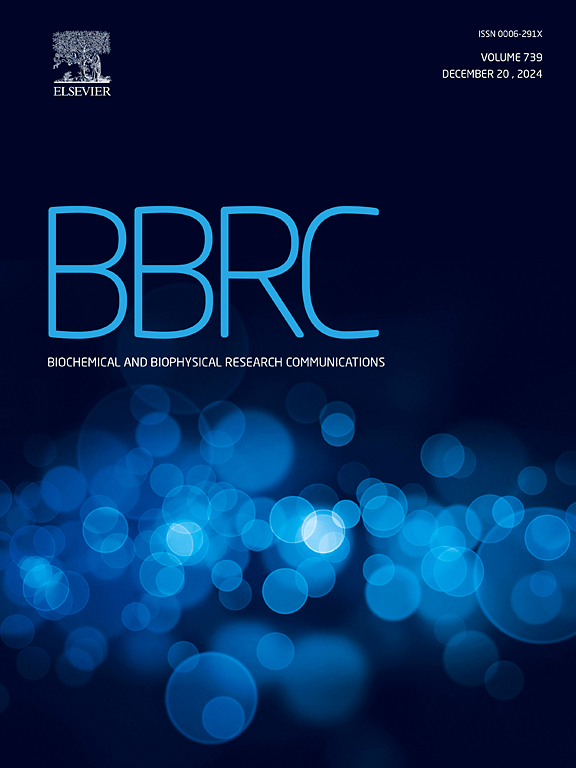Impact of high SAP2 expression on the invasion and adhesion abilities of Candida albicans in vaginal epithelial cells
IF 2.2
3区 生物学
Q3 BIOCHEMISTRY & MOLECULAR BIOLOGY
Biochemical and biophysical research communications
Pub Date : 2025-06-14
DOI:10.1016/j.bbrc.2025.152147
引用次数: 0
Abstract
Background
The link between SAP2 and Candida albicans' capacity to adhere to and invade host cells is notable, although the precise molecular mechanisms remain unclear. The purpose of this study was to examine how elevated SAP2 expression influences the invasion and adhesion capabilities of C. albicans in A431 cells using in vitro experiments and transcriptomic sequencing.
Methods
The effect of high SAP2 expression on the invasion of A431 cells by C. albicans was evaluated using lactate dehydrogenase (LDH) release assay. Morphological changes in hyphae were observed under a microscope during co-culture with A431 cells. The ability of C. albicans to adhere to A431 cells was assessed using an adhesion assay. Transcriptomic sequencing and qRT-PCR were used to examine changes in gene expression and associated signaling pathways in C. albicans after co-culture with A431 cells.
Results
After 1.5–2 h of co-culture, the number of A431 cell colonies adhered by the SC5314 strain was significantly higher than adhered by the SAP2-overexpressing SC5314 strain (pRB895-SAP2-SC5314). After 8 h, the SC5314 strain induced the formation of dense, elongated hyphae, whereas the pRB895-SAP2-SC5314 strain formed clustered, snowflake-like yeast forms. After 24 h, the LDH release assay revealed a significantly higher death rate of A431 cells in the SC5314 group. Differential expression analysis identified 50 upregulated and 10 downregulated genes in the pRB895-SC5314 strain relative to the SC5314 strain. A total of 1142 genes were upregulated and 1219 genes were downregulated in the pRB895-SAP2-SC5314 strain relative to the SC5314 strain. In addition, 1159 genes were upregulated and 1228 genes were downregulated in the pRB895-SAP2-SC5314 strain relative to the pRB895-SC5314 strain. KEGG enrichment analysis indicated the MAPK signaling pathway associated with these genes, and qRT-PCR showed significant downregulation of genes such as TEC1.
Conclusion
Co-culture with A431 cells significantly inhibited hyphal growth and attenuated the invasion and adhesion abilities of the pRB895-SAP2-SC5314 strain. Several genes related to SAP2 were upregulated or downregulated, suggesting that the role of SAP2 in the pathogenic mechanisms of C. albicans is influenced by complex regulatory factors, with the MAPK signaling pathway serving as a key factor.
SAP2高表达对白色念珠菌阴道上皮细胞侵袭和粘附能力的影响
背景SAP2与白色念珠菌粘附和侵袭宿主细胞的能力之间的联系是值得注意的,尽管确切的分子机制尚不清楚。本研究的目的是通过体外实验和转录组测序来研究SAP2表达升高如何影响白色念珠菌在A431细胞中的侵袭和粘附能力。方法采用乳酸脱氢酶(LDH)释放法观察SAP2高表达对白色念珠菌侵袭A431细胞的影响。在显微镜下观察菌丝与A431细胞共培养时的形态变化。使用粘附试验评估白色念珠菌粘附A431细胞的能力。利用转录组测序和qRT-PCR技术检测白色念珠菌与A431细胞共培养后基因表达及相关信号通路的变化。结果共培养1.5 ~ 2 h后,SC5314菌株黏附的A431细胞菌落数显著高于过表达sap2的SC5314菌株(pRB895-SAP2-SC5314)。8 h后,SC5314菌株诱导形成密集的、细长的菌丝,而pRB895-SAP2-SC5314菌株形成簇状的、雪花状的酵母形态。24h后,LDH释放试验显示SC5314组A431细胞死亡率显著升高。差异表达分析发现,pRB895-SC5314菌株与SC5314菌株相比,有50个基因表达上调,10个基因表达下调。与SC5314相比,pRB895-SAP2-SC5314共有1142个基因表达上调,1219个基因表达下调。此外,pRB895-SAP2-SC5314菌株与pRB895-SC5314菌株相比,有1159个基因表达上调,1228个基因表达下调。KEGG富集分析表明MAPK信号通路与这些基因相关,qRT-PCR显示TEC1等基因显著下调。结论pRB895-SAP2-SC5314与A431细胞共培养可显著抑制菌丝生长,降低其侵袭和粘附能力。多个与SAP2相关的基因上调或下调,提示SAP2在白色念珠菌发病机制中的作用受到复杂调控因子的影响,其中MAPK信号通路是一个关键因素。
本文章由计算机程序翻译,如有差异,请以英文原文为准。
求助全文
约1分钟内获得全文
求助全文
来源期刊
CiteScore
6.10
自引率
0.00%
发文量
1400
审稿时长
14 days
期刊介绍:
Biochemical and Biophysical Research Communications is the premier international journal devoted to the very rapid dissemination of timely and significant experimental results in diverse fields of biological research. The development of the "Breakthroughs and Views" section brings the minireview format to the journal, and issues often contain collections of special interest manuscripts. BBRC is published weekly (52 issues/year).Research Areas now include: Biochemistry; biophysics; cell biology; developmental biology; immunology
; molecular biology; neurobiology; plant biology and proteomics

 求助内容:
求助内容: 应助结果提醒方式:
应助结果提醒方式:


